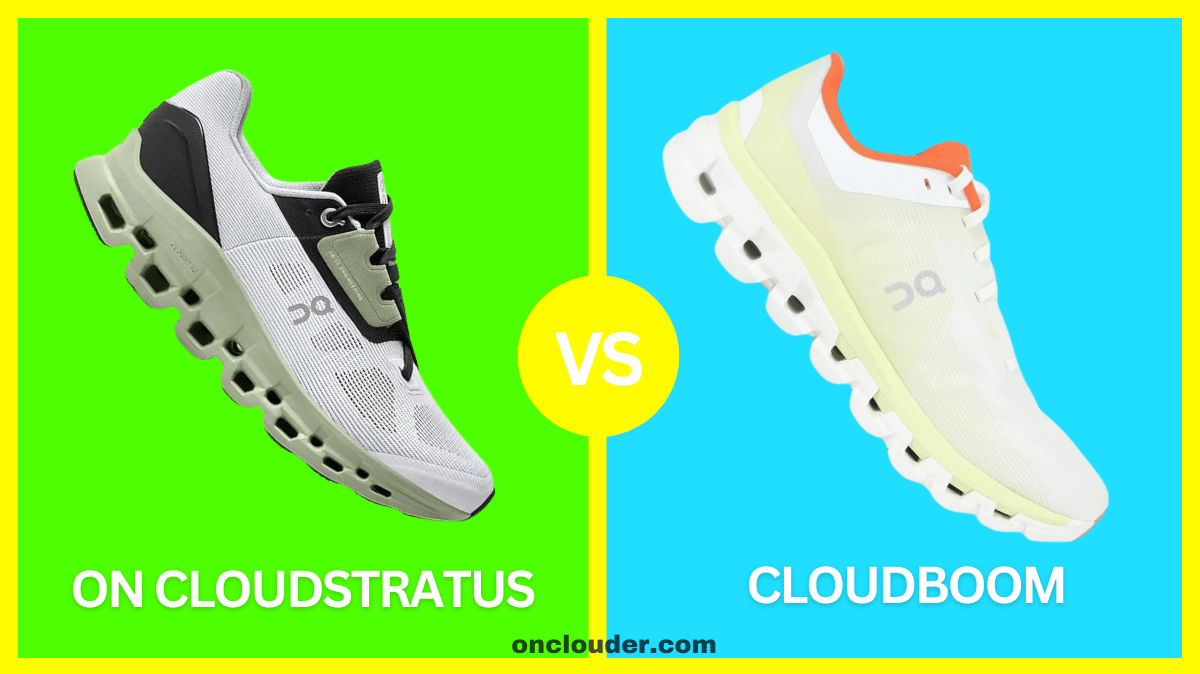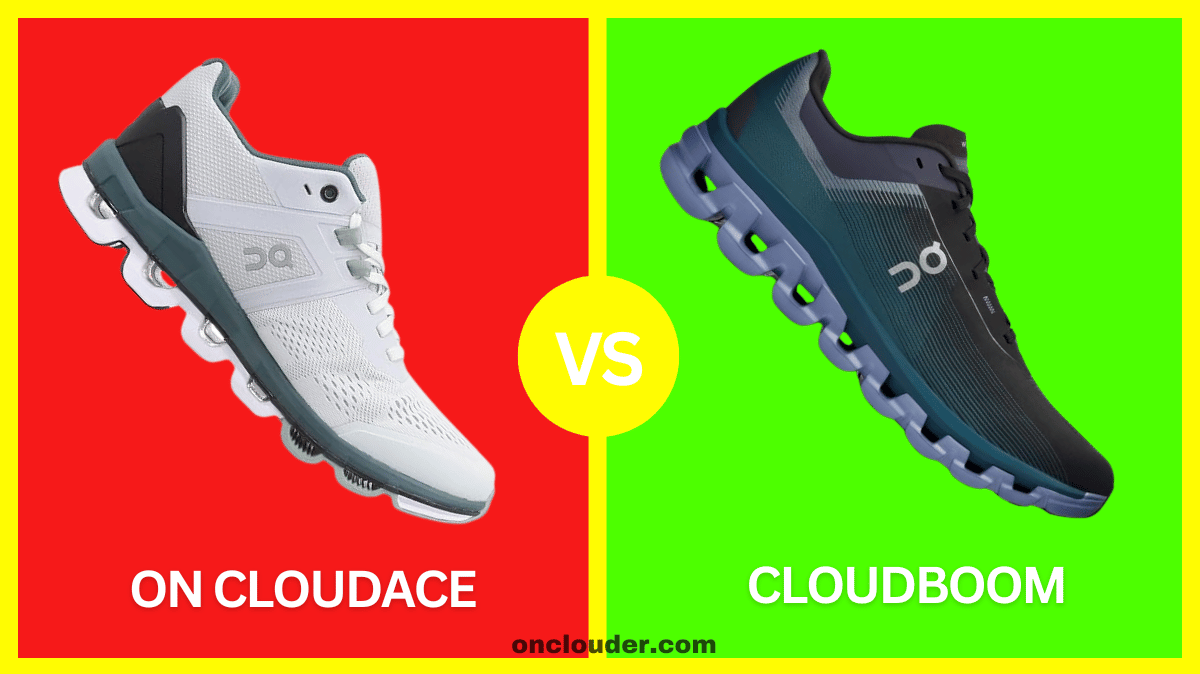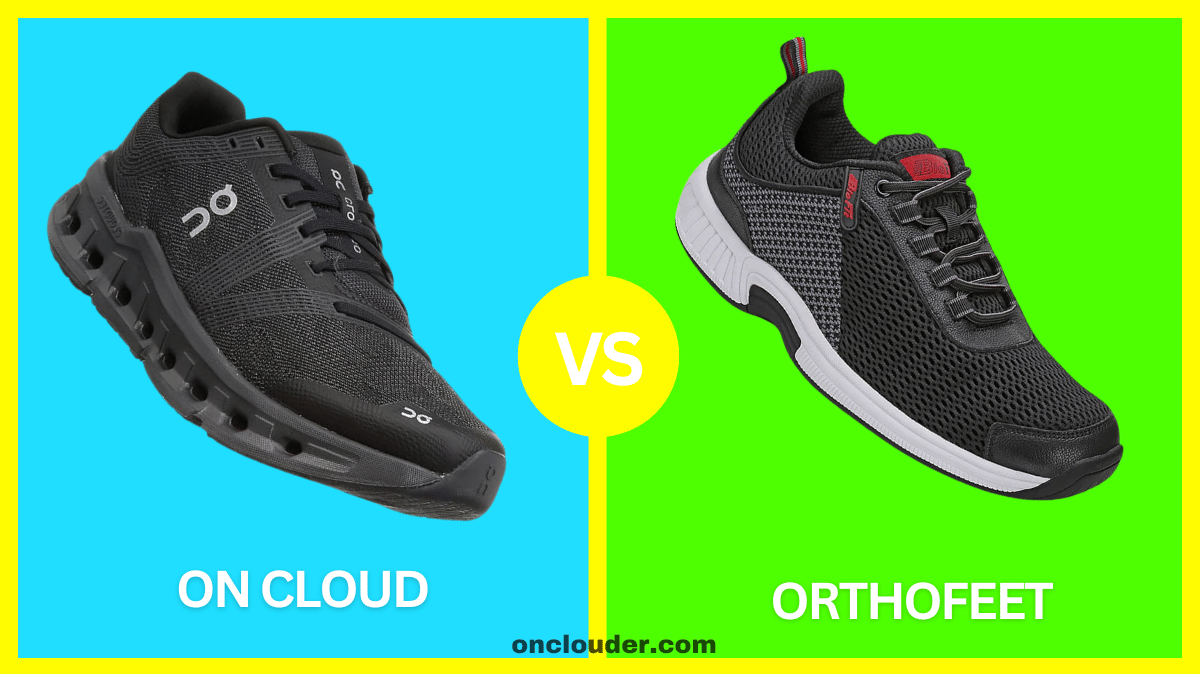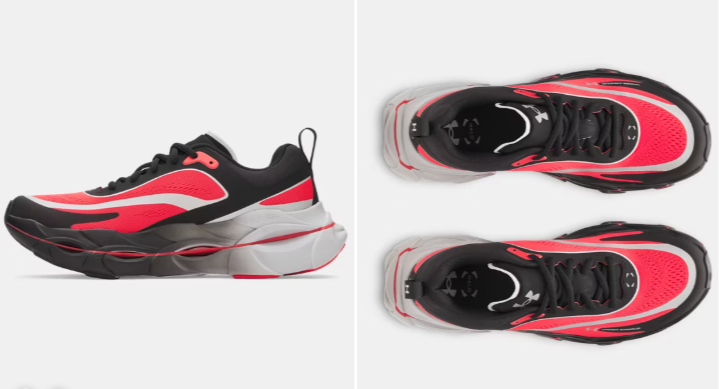Are you ready to learn about two awesome running shoes from On? Today, we’re going to compare the On Cloudstratus and the On Cloudboom.
These shoes might sound like they’re from outer space, but they’re actually designed to help you run faster and more comfortably right here on Earth!

Contents
- 1 Quick Comparison: On Cloudstratus vs Cloudboom Shoes
- 2 What Makes These Shoes Special?
- 3 Durability: Which Shoe Lasts Longer?
- 4 Breathing: Keeping Your Feet Cool
- 5 Cushioning: Soft Landings for Your Feet
- 6 Shoe Fit: Finding Your Perfect Match
- 7 Stability: Keeping You Steady on Your Feet
- 8 Comfort: Happy Feet, Happy Runner
- 9 Quality: Swiss Engineering at Its Finest
- 10 Style: Looking Good on the Run
- 11 Size: Finding the Right Fit
- 12 Material: What Are These Shoes Made Of?
- 13 Weight: Light on Your Feet
- 14 Flexibility: Bend and Flex
- 15 Water Resistance: Staying Dry on the Run
- 16 Sole: The Foundation of Your Run
- 17 User Reviews: What Do Other Runners Think?
- 18 Price: Investing in Your Run
- 19 Pros and Cons
- 20 Conclusion
- 21 Frequently Asked Questions
Quick Comparison: On Cloudstratus vs Cloudboom Shoes
The main difference between On Cloudstratus and Cloudboom shoes is their purpose. Cloudstratus is made for everyday running and long distances. It has more cushioning and support, making it comfy for regular use.
Cloudboom is designed for racing and speed. It’s lighter and less cushioned, helping you run faster in short races.
Now, let’s create a detailed comparison table for On Cloudstratus vs Cloudboom Shoes:
| Feature | On Cloudstratus | On Cloudboom |
| Purpose | Everyday running, long distances | Racing, speed workouts |
| Cushioning | More cushioning, double CloudTec | Less cushioning, single CloudTec |
| Weight | Heavier (about 10.7 oz) | Lighter (about 7.9 oz) |
| Fit | Roomier, especially in toe box | Snugger fit |
| Durability | More durable for daily use | Less durable, made for race day |
| Stability | More stable, good for overpronation | Less stable, focused on speed |
| Breathability | Very breathable mesh upper | Thin, highly breathable upper |
| Flexibility | More flexible | Stiffer for better energy return |
| Best For | Daily training, long runs | Short races, speed workouts |
| Price | $150 – $170 | $180 – $200 |
In summary: On Cloudstratus and Cloudboom are both great running shoes, but they’re made for different things. Cloudstratus is like a comfy everyday shoe. It’s good for long runs and training because it has lots of cushioning and support. It’s also more durable, so it lasts longer.
Cloudboom is more like a race car for your feet. It’s super light and helps you run fast in short races. But it’s not as comfy for long runs or everyday use. It’s also a bit more expensive than the Cloudstratus.
Also Read: On Cloudventure vs Cloudboom
What Makes These Shoes Special?
Before we dive into the details, let’s talk about why these shoes are so cool. On is a company that makes running shoes with a special technology called CloudTec. It’s like having little clouds under your feet!
But each shoe is designed for different types of running, so let’s find out which one might be best for you.
Durability: Which Shoe Lasts Longer?
Cloudstratus: Built to Last
The Cloudstratus is like the tortoise in the famous race – slow and steady wins! This shoe is made to last for a long time. It has strong materials that can handle lots of running on different surfaces.
If you’re someone who likes to run every day or go on long runs, the Cloudstratus might be a great choice for you.
Cloudboom: Speed Over Longevity
The Cloudboom, on the other hand, is more like the hare in the race – super fast but not built for the long haul. It’s designed for speed and performance during races. While it’s still a well-made shoe, it might not last as long as the Cloudstratus if you use it for everyday running.
Breathing: Keeping Your Feet Cool
Cloudstratus: Breathe Easy
Imagine your feet could wear a light, breezy t-shirt. That’s what the Cloudstratus feels like! It has a special mesh upper that lets air flow in and out easily. This means your feet stay cool and dry, even on hot days or during long runs.
Cloudboom: Racing Ventilation
The Cloudboom also has good breathability, but it’s designed a bit differently. It has a thin, lightweight upper that lets air through quickly. This is great for races when you need to stay cool and light on your feet.
Cushioning: Soft Landings for Your Feet
Cloudstratus: Double the Clouds
Remember those clouds we talked about earlier? Well, the Cloudstratus has two layers of them! This means extra cushioning for your feet. It’s like running on a soft, bouncy surface that helps protect your feet and legs from the hard ground.
Cloudboom: Fast and Firm
The Cloudboom has less cushioning than the Cloudstratus. It’s designed to be firm and responsive, which means it helps you bounce back quickly with each step. This is great for running fast, but it might not feel as soft on your feet during longer runs.
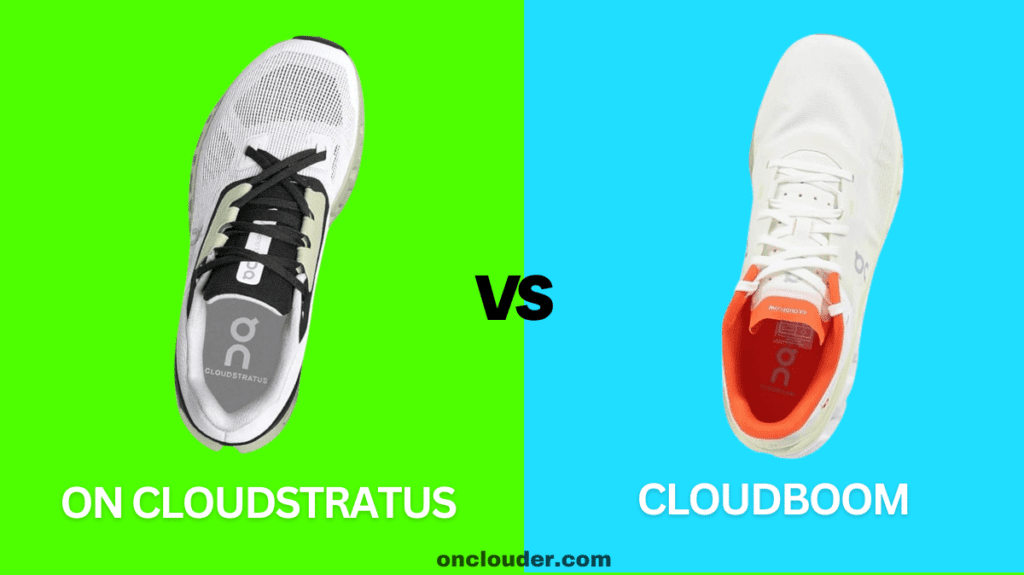
Shoe Fit: Finding Your Perfect Match
Cloudstratus: Room to Wiggle
The Cloudstratus is known for having a roomy toe box. This means there’s plenty of space for your toes to move around and spread out naturally. It’s great if you have wider feet or if you like a little extra room in your shoes.
Cloudboom: Snug and Secure
The Cloudboom has a tighter, more snug fit. It’s designed to hold your foot securely in place during fast runs and races. This can help you feel more connected to the ground and give you better control when you’re running at high speeds.
Stability: Keeping You Steady on Your Feet
Cloudstratus: Extra Support
If you sometimes feel wobbly when you run, the Cloudstratus might be a good choice for you. It has features that help keep your feet stable and prevent them from rolling inward (which runners call overpronation). This can help you feel more confident and secure with each step.
Cloudboom: Racing Precision
The Cloudboom is designed more for speed than stability. It doesn’t have as much support as the Cloudstratus, but it does have a special plate in the sole that helps guide your foot as you run. This can help you maintain a steady, efficient stride during races.
Comfort: Happy Feet, Happy Runner
Cloudstratus: All-Day Comfort
The Cloudstratus is like a cozy bed for your feet. With its extra cushioning and roomy fit, many runners find it very comfortable for long runs or all-day wear. If comfort is your top priority, this might be the shoe for you.
Cloudboom: Race-Day Focus
The Cloudboom is comfortable in its own way, but it’s designed more for performance than all-day wear. It’s lightweight and responsive, which can feel great during a race, but might not be as comfortable for everyday use or long, slow runs.
Quality: Swiss Engineering at Its Finest
Cloudstratus: Built to Last
On is a Swiss company, and like Swiss watches, their shoes are known for being well-made. The Cloudstratus uses high-quality materials and careful construction to create a shoe that can stand up to lots of running.
Cloudboom: Racing Excellence
The Cloudboom also shows off On’s commitment to quality, but in a different way. It uses lightweight, high-performance materials to create a shoe that’s perfect for race day. While it might not be as durable as the Cloudstratus, it’s still a well-crafted shoe.
Also Read: On Cloudflyer vs Cloudboom
Style: Looking Good on the Run
Cloudstratus: Bold and Eye-Catching
The Cloudstratus has a unique look with its double layer of cloud pods on the sole. It comes in several color options, from bright and bold to more subtle shades. If you like a shoe that stands out, this might be the one for you.
Cloudboom: Sleek and Speedy
The Cloudboom has a more streamlined look that screams “speed.” It has a low profile and comes in colors that often include white or black with bright accents. If you want a shoe that looks fast even when you’re standing still, check out the Cloudboom.
Size: Finding the Right Fit
Both the Cloudstratus and Cloudboom come in a range of sizes for men and women. However, they might fit differently due to their design. Let’s look at a size comparison:
| Shoe Model | Runs Small | True to Size |
| Cloudstratus | X | |
| Cloudboom | X |
The Cloudstratus tends to fit true to size, while the Cloudboom often feels a bit snug. Some runners recommend going up a half size in the Cloudboom for the best fit.
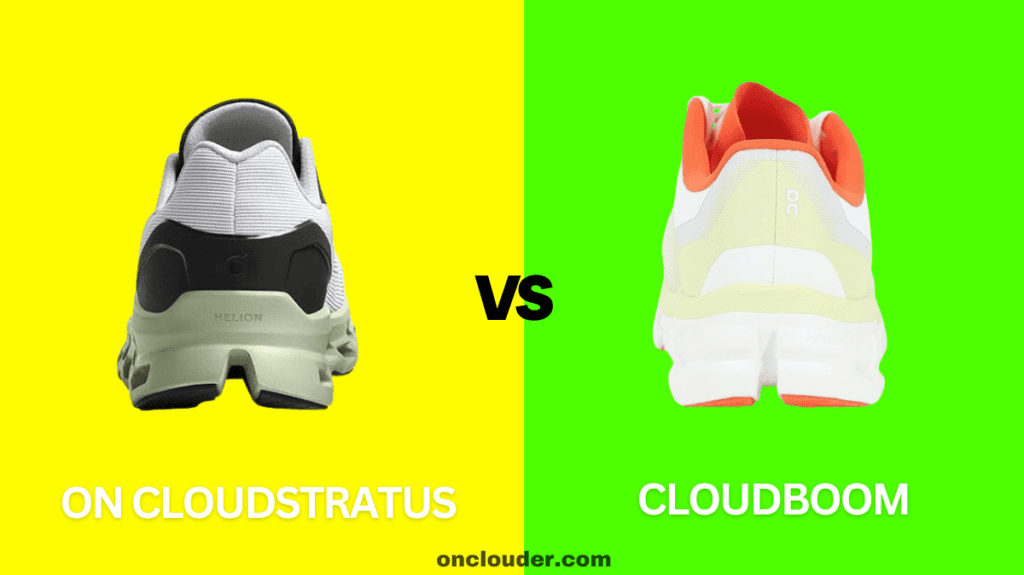
Material: What Are These Shoes Made Of?
Cloudstratus: Durable and Supportive
The Cloudstratus uses a mix of materials to create a supportive and long-lasting shoe:
- Upper: Engineered mesh for breathability
- Midsole: Helion superfoam for cushioning
- Outsole: Rubber for durability and grip
Cloudboom: Light and Fast
The Cloudboom focuses on lightweight, high-performance materials:
- Upper: Ultra-thin engineered mesh
- Midsole: Helion superfoam with a carbon-fiber infused Speedboard
- Outsole: Rubber with a specific grip pattern for road racing
Weight: Light on Your Feet
When it comes to weight, there’s a noticeable difference between these two shoes:
| Shoe Model | Approximate Weight (Men’s Size 9) |
| Cloudstratus | 10.7 oz (305 g) |
| Cloudboom | 7.9 oz (225 g) |
The Cloudboom is significantly lighter, which can make a big difference when you’re trying to run fast in a race.
Flexibility: Bend and Flex
Cloudstratus: Balanced Flexibility
The Cloudstratus offers a good balance of flexibility and support. It’s designed to flex with your foot as you run, but still provide structure where you need it.
Cloudboom: Racing Responsiveness
The Cloudboom is less flexible due to its carbon-fiber plate. This stiffness is intentional, as it helps propel you forward with each step during fast runs and races.
Water Resistance: Staying Dry on the Run
Neither the Cloudstratus nor the Cloudboom is designed to be fully waterproof. However, they do handle water differently:
Cloudstratus: Quick-Drying Design
The Cloudstratus has a mesh upper that doesn’t keep water out, but it does dry quickly if it gets wet. This can be helpful if you run through a puddle or get caught in a light rain.
Cloudboom: Minimal Water Absorption
The Cloudboom’s thin upper doesn’t absorb much water, which can help keep your feet feeling light even in damp conditions. However, like the Cloudstratus, it’s not waterproof.
Also Read: On Cloudace vs Cloudboom
Sole: The Foundation of Your Run
Cloudstratus: Double Cloud Comfort
The Cloudstratus has a unique double-layer of CloudTec elements in the sole. This provides extra cushioning and helps absorb the impact of each step, especially in the heel and forefoot areas.
Cloudboom: Speed-Focused Design
The Cloudboom’s sole is flatter and features On’s CloudTec technology combined with a carbon-fiber infused Speedboard. This design aims to provide a fast, responsive ride that can help you pick up the pace.
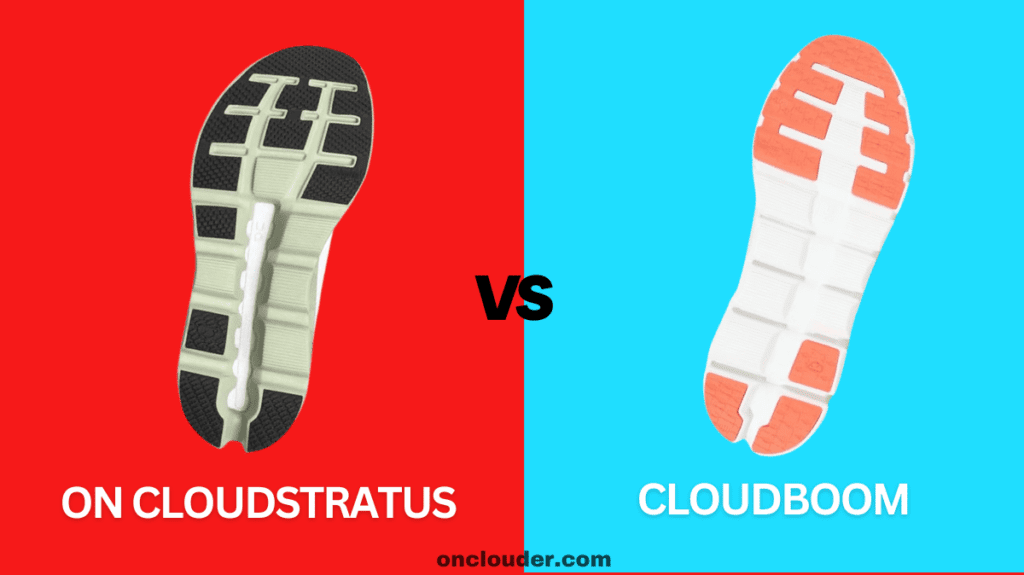
User Reviews: What Do Other Runners Think?
Let’s see what other runners have to say about these shoes:
| Shoe Model | Comfort | Performance | Durability | Overall Rating |
| Cloudstratus | ⭐⭐⭐⭐⭐ | ⭐⭐⭐⭐ | ⭐⭐⭐⭐⭐ | 4.5/5 |
| Cloudboom | ⭐⭐⭐ | ⭐⭐⭐⭐⭐ | ⭐⭐⭐ | 4/5 |
Cloudstratus User Review: “I love my Cloudstratus shoes! They’re so comfortable for my long runs and daily training. My feet feel great even after running for hours.”
Cloudboom User Review: “The Cloudboom helped me set a new personal best in my last 10k race. They’re super light and fast, but I wouldn’t use them for my everyday runs.”
Price: Investing in Your Run
Both the Cloudstratus and Cloudboom are premium running shoes, which means they cost more than basic running shoes. Here’s a general price comparison:
| Shoe Model | Price Range |
| Cloudstratus | $150 – $170 |
| Cloudboom | $180 – $200 |
Remember, prices can vary depending on where you buy the shoes and if they’re on sale.
Pros and Cons
| Shoe | Pros ✅ | Cons ⚠️ |
|---|---|---|
| On Cloudstratus | Extra cushioning for a super comfy run | Heavier than some other running shoes |
| Great for long runs and everyday training | Might feel too thick if you like to feel the ground | |
| Helps protect your feet from hard impacts | Not the best for super fast running | |
| Good for runners who need more support | Can feel warm on very hot days | |
| Durable and lasts a long time | More expensive than basic running shoes | |
| On Cloudboom | Super light and helps you run fast | Not as comfortable for long, slow runs |
| Special carbon plate makes you feel springy | Less durable than everyday running shoes | |
| Great for races and speed training | Doesn’t provide much support for your feet | |
| Very breathable and keeps your feet cool | Expensive compared to regular running shoes | |
| Helps you feel connected to the ground | Might feel too firm if you like soft cushioning |
Conclusion
After looking at all these details, you might be wondering which shoe you should choose. Here’s a simple way to think about it:
Choose the Cloudstratus if:
- You want a comfortable shoe for everyday running
- You need extra cushioning and support
- You’re planning to run long distances
Choose the Cloudboom if:
- You’re looking for a lightweight racing shoe
- You want to run fast in shorter races
- You prefer a firmer, more responsive feel
Remember, the best shoe for you is the one that feels comfortable and helps you enjoy running. If you can, try both shoes on and see which one feels better on your feet.
Frequently Asked Questions
Can I use the Cloudboom for my daily runs?
While you can use the Cloudboom for daily runs, it’s really designed for racing and speed workouts. The Cloudstratus might be a better choice for everyday training.
Are these shoes good for beginners?
The Cloudstratus is generally better for beginners because of its cushioning and support. The Cloudboom is more specialized and might be challenging for new runners.
How often should I replace these shoes?
Most running shoes, including these, should be replaced after 400-500 miles of use. Keep track of your mileage and watch for signs of wear.
Can I use these shoes if I have flat feet?
The Cloudstratus offers more support and might be better for flat feet. However, it’s always best to consult with a running shoe expert or podiatrist for personalized advice.
Are these shoes good for running on trails?
Both shoes are designed primarily for road running. For trail running, On makes other models specifically designed for off-road use.

